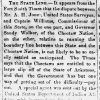calsfoundation@cals.org
Cherokee Boundary Line
aka: Old Cherokee Boundary Line
The Old Cherokee Boundary Line served as the eastern border of the first land set aside for Native Americans in Arkansas. The Treaty of the Cherokee Agency of 1817 created the definition for the line as beginning at the confluence of Point Remove Creek and the Arkansas River near present-day Morrilton (Conway County). The line was then to be marked in a northeasterly direction to Shields Ferry on the White River. General William Rector, along with commissioners appointed by the Cherokee, conducted the original survey and filed a report with the Government Land Office in 1819. Rector reported a distance of seventy-one miles and fifty-five chains.
Rector’s survey and report were intended to satisfy both some Cherokee residents and some residents of Arkansas Territory who did not accept the language of the treaty and sought adjustments to the line. In 1819, a second treaty was intended to meet concerns of both parties. A part of the problem involved the removal of white settlers from the described Cherokee lands.
The term “Old Cherokee Boundary Line” reflects the eastern line that remains in the U.S. Geological Quadrangle maps and other prominent maps. The counties and their approximate miles of boundary line are: Conway (twenty), Faulkner (six), Van Buren (nine), Cleburne (thirty-one), and Independence (five). The line lies diagonally across Greers Ferry Lake in Cleburne County. The U.S. Army Corps of Engineers developed a campground and park on the northeastern portion of the lake to commemorate the significance of the boundary line and the lake. It also developed and operates a large RV park on the Arkansas River that recognizes the beginning point near Point Remove Creek.
While the surveys for sections and townships were completed after the Cherokee had given up their land in Arkansas in 1828, the boundary was a prominent marker and was frequently used in early land descriptions. The marker has shown continued and even increased significance over the years. Surveyors in the counties that the boundary line impacts have long encountered language about the line in legal descriptions and have worked to resolve disputes that relate to the “exact” location of the line. These incidences increased as the area experienced the Fayetteville Shale natural gas development beginning in 2004. The boundary line aligns, in part, with this important economic development. Thus, a new generation of surveyors was required to cope with the peculiarities associated with the Old Cherokee Boundary Line.
While the Treaty of 1817 gave specific points of origin and termination, those persons involved in marking the boundary line faced obstacles associated with uncharted wilderness terrains. Surveying techniques of the time were rudimentary and certainly inadequate by modern standards. They predated full understanding of the concept of magnetic variation (declination). These included the effects caused by local soils that contain notable amounts of iron and other magnetic compounds. It is now recognized that even the original surveyors’ metal surveying equipment may have had significantly impacted the magnetic behavior of their compass readings as reported by General Rector.
Numerous mile markers and other monuments have been placed along the line. Over the years, many of these markers have been identified by surveyors and recognized by historical groups. Representative of the confusion that has surrounded this important boundary, the Arkansas History Commission (now called the Arkansas State Archives), during the state’s centennial celebration in 1936, placed a monument on Cherokee Street in Morrilton that, in an elaborate inscription, erroneously states that the line runs “in a Northwesterly direction.”
For additional information:
Bolton, S. Charles. Arkansas, 1800–1860: Remote and Restless. Fayetteville: University of Arkansas Press, 1998.
Shinn, Josiah H. Pioneers and Makers of Arkansas. Chicago: Genealogical and Historical Publishing Company, 1908.
“Treaty with the Cherokee: July 8, 1817.” http://www.firstpeople.us/FP-Html-Treaties/TreatyWithTheCherokee1817.html (accessed February 9, 2022).
Larry Taylor
Springfield, Arkansas
 Choctaw Boundary Line
Choctaw Boundary Line Point Remove (Conway County)
Point Remove (Conway County)



Comments
No comments on this entry yet.